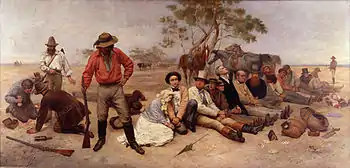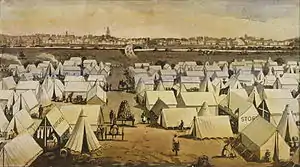St Kilda Road robberies
In the years following the Victorian gold rush which began in 1851, St Kilda Road, a long track through the southern suburbs to St Kilda and on to Brighton, was the scene of frequent hold-ups by armed bandits, known in Australia as bushrangers (though this was normally applied to bandits in the country side, rather than uncleared areas of scrub along a fairly busy city road).

One of the most infamous took place in the afternoon of 16th October 1852, when 19 people were robbed and tied up together at a spot near Glenhuntly Road, later depicted in William Strutt's Bushrangers on the St Kilda Road, painted more than 30 years later in 1887 (now held by the Ian Potter Museum of Art).
The last major offense

On 17 March 1853, gold-buyer Edward Ritter and his brother-in-law Samuel Maxwell Alexander were riding in their chaise-cart from St Kilda to Melbourne. A gang of eight or nine men attempted to hold them up near Canvas Town (now South Melbourne - this robbery may not have been on St Kilda Road itself), but Ritter managed to pull away from the potential robbers. A volley of shots were fired, of which three hit Ritter in the legs, without causing any serious injury.
Ritter and Alexander furnished good descriptions of their assailants, two of whom had been amongst a similar group who had tried to rob Ritter about three weeks earlier, who he recognised. The Government offered a reward of £1600, calculated at £200 per head, for their arrests leading to conviction, and the Melbourne police began to round up likely suspects. Seven men faced Justice Redmond Barry on 18 April 1853, five being convicted - Higginbotham, Little, Murphy William Burns, and James Burns - each sentenced to ten years’ hard labour on the roads, the first two in chains. Two others, Thompson and James Grimes, were acquitted.[2] Grimes had been arrested on suspicion of taking part in the Nelson robbery in 1852, but there had been insufficient evidence to convict him.
With the breaking up of this gang law and order were partially returned to the roads of Melbourne.
George Wilson who was believed to be involved was later hanged for the McIvor Escort Robbery.
References
- Ian Potter Museum collection: Bushrangers Archived 28 February 2011 at the Wayback Machine, u21museums.unimelb.edu.au. Retrieved on 9 January 2011.
- "THE ST. KILDA BUSHRANGERS". Argus (Melbourne, Vic. : 1848 - 1957). 20 April 1853. p. 4. Retrieved 23 July 2019.
- John Rochfort, The Adventures of a Surveyor in New Zealand and the Australian Goldfields, London, 1853
- Frank Clune, Captain Melville